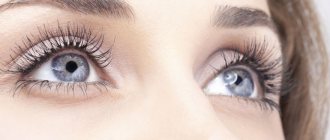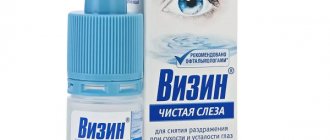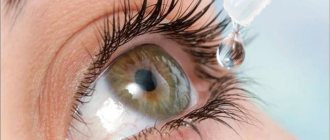132
Author of the article
Tsareva Elena Vladimirovna
Reading time: 14 minutes
A A
To relieve the symptoms of viral conjunctivitis in adults, the use of eye drops is prescribed. Some drugs are universal, that is, they can be used to treat a patient regardless of age and cause of the disease. Before using the medicine, you should consult a specialist.
- Drops overview
- Oftalmoferon and Oftan Idu
- Tebrofen and Gludantan
- Poludan and Interferon
- Tobrex and Floxal
- Albucid and Florenal
- Conclusion
How is conjunctivitis treated?
The prescribed drops depend on the nature of conjunctivitis: bacterial, viral, allergic, purulent. Before instillation of the drug, it is necessary to rinse the eyes with a special agent (furacilin, chamomile decoction); it is possible to use eye ointments together.
When instilling, you should be careful not to touch the eye mucosa with the pipette to prevent the infection from passing from one eye to another. Bacterial and viral conjunctivitis are contagious.
Bacterial conjunctivitis
With this type of infection, swelling, redness of the conjunctiva, pain and burning sensation, and the release of copious fluid (purulent or mucopurulent) are observed. For bacterial conjunctivitis, antibiotic drops are used that act on the pathogen.
Levomycetin
Cheap eye drops with a wide spectrum of action. Cannot be used during breastfeeding or pregnancy. After instillation, local allergic reactions are possible.
Sulfacyl Sodium
Popularly known as Albucid, due to its good effectiveness and affordable, low price. Used for purulent conjunctivitis; after instillation, short-term redness, swelling of the mucous membrane and itching may be observed.
Tobrex
The antibiotic is based on tobramycin, which affects many strains of bacteria. Produced in Spain. It is characterized by absolute safety, since it can be used in newborns. Tobrex is approved for use during pregnancy and breastfeeding.
Tobris
Indian generic (substitute) of Tobrex, based on tobramycin. It differs in the manufacturer of raw materials, degree of purification and lower price.
Okomistin
Local antiseptic solution, approved for use from three years of age. After instillation of Okomistin, a short-term burning sensation and discomfort are observed, which go away on their own, without treatment or discontinuation of the drug after 20-30 seconds.
Gentamicin
A cheap antibiotic that acts on the pathogen. Cannot be used during pregnancy and breastfeeding. If used during lactation, breastfeeding is discontinued.
Dexa-Gentamicin
Available in the form of eye drops and ointments, it has a combined composition: the antibacterial substance gentamicin and the corticosteroid dexamethasone. Thanks to this combination, it fights bacterial infection, relieves irritation, redness, itching, and relieves inflammation. Restrictions on the use of Dex-Gentamicin are viral, fungal, herpetic diseases of the organs of vision, acute purulent lesions of the conjunctiva.
Vitabact
Antimicrobial agent for bacterial infections. Not studied in pregnant and lactating groups. Therefore, it is not advisable for them to use Vitabact. The only contraindication is hypersensitivity to the components of the drug.
Phloxal
In the pharmacy assortment, Floxal is presented in two types: eye ointment and drops.
The first form is recommended for use at night, the second - during the day. After use, photophobia, discomfort, itching, short-term redness of the conjunctiva, dryness and burning may occur.
Drops with Ciprofloxacin
They have an antibacterial effect. They are produced under the trade names Ciprofloxacin, Tsiprolet, Tsipromed. Approved for use in children's practice from one year onwards.
Viral
Develops due to exposure to viruses (adenovirus, enterovirus, herpes virus) or against the background of other diseases (ARVI, influenza). It mainly affects both eyes. It manifests itself as severe redness of the white, profuse lacrimation, the appearance of pus, itching, photophobia and follicles on the conjunctiva.
Oftalmoferon
A complex drug for conjunctivitis caused by adenovirus, enterovirus, and herpes infection.
It contains human interferon and diphenhydramine. The drops help fight the pathogen, increase local immunity, and relieve the patient from allergic manifestations of the disease (itching, burning, redness).
The advantages of Oftalmoferon are safety, no side effects.
Aktipol
Aktipol has antiviral and immunomodulatory properties. Promotes the production of interferon in the body. Improves the processes of restoration and healing of the cornea. Rarely leads to allergic reactions.
Allergic
For allergic conjunctivitis, drugs from the following groups are prescribed: vasoconstrictors, antihistamines, corticosteroids and combination drugs. Additionally, it is possible to prescribe antiallergic tablets.
Allergodil
Antiallergic drops are based on the substance azelastine and are used for seasonal and non-seasonal allergies for treatment and prevention. Additionally, Allergodil can be used as prescribed by a specialist for bacterial infections of the organ of vision. After instillation, swelling, redness and discoloration of the mucous membrane, and increased sensitivity of the eye are possible. In pediatric practice, the medicine is used from 4 years of age.
Cromohexal
Antihistamine drug based on cromoglycic acid. The area of application of Cromohexal is allergic conjunctivitis, irritation by various factors (dust, dry air, household chemicals, pollen, etc.). Approved for use from 4 years of age.
Lecrolin
An analogue of the drug Cromohexal, also used from 4 years of age.
More information about the drug can be found here
Opatanol
Antihistamine medication is used from 3 years of age to relieve symptoms of allergic conjunctivitis. Undesirable reactions are rarely observed: blurred vision, lacrimation, swelling of the eyelids, keratitis, sensation of a foreign body in the eye.
More information about the drug can be found here
Visine Classic
The medicine is a vasoconstrictor and relieves the patient from itching, swelling of the conjunctiva, and redness. Visin Classic can be used for up to 5 days without the appointment of a specialist. Available in a regular bottle and disposable droppers, more convenient to use.
Vizin Alergy
It affects the allergic form of conjunctivitis, the effect occurs 6 minutes after instillation and lasts up to 12 hours. Visin Alergy should not be used when wearing contact lenses, pregnancy, breastfeeding, or under 12 years of age.
Dexamethasone
Belongs to the group of hormonal drugs, used only as prescribed by a specialist for allergic conjunctivitis. Dexamethasone should not be used for viral forms of the disease, fungal, acute purulent, mycobacterial eye diseases, or increased intraocular pressure.
Dexa-Gentamicin
A complex drug based on an antiallergic corticosteroid and an antibacterial component.
More information about the drug can be found here
Purulent
This type of conjunctivitis is caused by pathogenic bacteria and viruses. Accompanied by copious discharge of pus. Mainly found in children.
For treatment, a complex of drugs is used to eliminate the cause:
- antibacterial drugs;
- antiviral Oftalmoferon.
The therapy is complemented by the use of antibacterial eye ointment at night (Floxal, Gentamicin, Tetracycline).
The most prescribed antibiotic drops for purulent conjunctivitis: Sulfacyl Sodium (Albucid), Vitabact, Floxal, Tobrex.
Bottom line
Caution should be exercised to prevent infectious conjunctivitis. Parents should explain to their children the importance of keeping their hands clean and not touching their eyes with unwashed hands.
- You cannot use other people’s personal hygiene items: towels, handkerchiefs, etc.
- When coughing/sneezing, cover your mouth/nose with your hand, and then be sure to wash your hands with soap.
- It is unacceptable to use other people's contact lenses.
- Constant hand hygiene is an indispensable condition for the prevention of infectious ophthalmological diseases.
- At work/school, you should have disposable wet wipes with antibacterial properties with you to clean your hands.
- When swimming in the pool, you should protect your eyes with special goggles.
Remember that the human body is able to resist the aggression of microbes and viruses with a strong immune system, so strengthening the immune system is a top priority. You can strengthen the immune system in different ways: vitamin nutrition, hardening, physical exercise. No viruses will harm you if you have a strong immune defense.
Sources used:
- Diagnostic reference book for an ophthalmologist / P.A. Bezdetko, S.F. Zubarev, N.V. Panchenko. - M.: Phoenix, 2006.
- Lesions of the nervous system and organ of vision / R.I. Korovenkov, L.M. Tibekina. - M.: ELBI-SPb, 2012.
- 100% vision / S.V. Dubrovskaya. - M.: Book on Demand, 2009.
- Wikipedia article
Drops for children
In pediatric practice, the following medications are considered the safest for conjunctivitis: Tobrex, Oftalmoferon, Tobris, Tsipromed and its analogues for the active substance, Levomycetin, Sulfacyl Sodium. All drugs are used strictly as prescribed by the doctor.
Tobrex
Antibiotic drops are used for bacterial conjunctivitis. Safe, no age restrictions. After instillation, allergic manifestations are possible in the form of itching, redness of the installation site, and increased lacrimation.
Oftalmoferon
It is used in pediatric practice from birth as a primary remedy for viral conjunctivitis and an auxiliary measure for the treatment of bacterial infections. The drops are safe and do not cause unwanted reactions. The bottle must be stored in the refrigerator.
Tobris
A cheaper analogue of Tobrex, which has an antibacterial effect.
Tsipromed
It is used for bacterial conjunctivitis in children from one year of age. Known analogues of the drug: Ciprofloxacin, Tsiprolet.
Levomycetin
Used to treat inflammatory eye diseases in children from 4 weeks.
More information about the drug can be found here
Sulfacyl Sodium
Area of application: bacterial conjunctivitis, gonorrheal diseases and blenorrhea in newborns. Can be used from birth.
Traditional methods
Herbal lotions and eye washes are of auxiliary value in healing from infectious conjunctivitis. They create favorable conditions for effective fight against pathology.
Rose hip decoction
This decoction is used to wash the eyes for infectious conjunctivitis in adults. Preparation of the decoction: 2 tsp of rose hips crushed in a mortar should be steamed with boiling water (1 glass) and left to simmer in a water bath. After 5-7 minutes, the cup of broth is removed from the pan of water and left to steep, covered, for 40-45 minutes. The filtered decoction is used to treat the eyelids up to five times a day.
Dill juice
Freshly squeezed dill juice is used to treat eyes with inflammation. Well-washed plant branches are scrolled through a meat grinder, cotton pads (or gauze) are moistened in the resulting juice and applied to closed eyelids for 15-17 minutes. The application is repeated up to five times a day. The juice of the plant quickly relieves symptoms of irritation.
If there is no fresh dill, you can use applications from the seeds of the plant. Take a spoonful of dry seeds per cup of boiling water and leave for 60-65 minutes. The water should be boiling. Applications are made in the same way as from juice.
Chamomile infusion
The product is used as an antiseptic for inflammation of the mucous membranes of the visual apparatus. A pinch of dried flowers is steamed in a cup of boiling water and allowed to sit under the lid. After half an hour, the infusion needs to be filtered. Make applications on the eyelids 4-5 times a day. Chamomile relieves irritation and soothes diseased tissues.
Useful video
Dr. Komarovsky about conjunctivitis in a child: causes of the disease, treatment methods and signals for urgent consultation with a specialist.
Author's rating
Author of the article
Alexandrova O.M.
Articles written
2029
about the author
Was the article helpful?
Rate the material on a five-point scale!
If you have any questions or want to share your opinion or experience, write a comment below.











